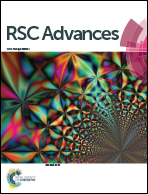Molecular dynamics and dissipative particle dynamics simulations of the miscibility and mechanical properties of GAP/DIANP blending systems
Abstract
Molecular dynamics (MD) and dissipative particle dynamics (DPD) simulations were performed to investigate the compatibility and mechanical properties of GAP (glycidyl azido polymer, an azido binder) and DIANP (1,5-diazido-3-nitrazapentane, an azido plasticizer). To determine the appropriate simulated chain length (n) of GAP, the solubility parameter (δ) was examined with n = 5, 10, 20, 30, and 40. The obtained δ decreases with the increasing n and when n reaches to 20, δ changes little and gives good agreement with the experimental data. Considering the computational costs, the chain length of GAP was selected to be 20. Then a series of blending systems of GAP (n = 20) and DIANP with mass ratios of 78.4/21.6 (I), 57.7/42.3 (II), and 37.7/62.3 (III) were constructed and studied. Results of solubility parameters, Flory–Huggins interaction parameters, blend binding energy distributions and mesoscopic morphologies all show that GAP and DIANP have good miscibility with each other. Compared with the mechanical properties of the pure GAP, it is found that addition of DIANP can enhance the plastic properties of GAP and the blend II has the best tenacity and ductility.


 Please wait while we load your content...
Please wait while we load your content...